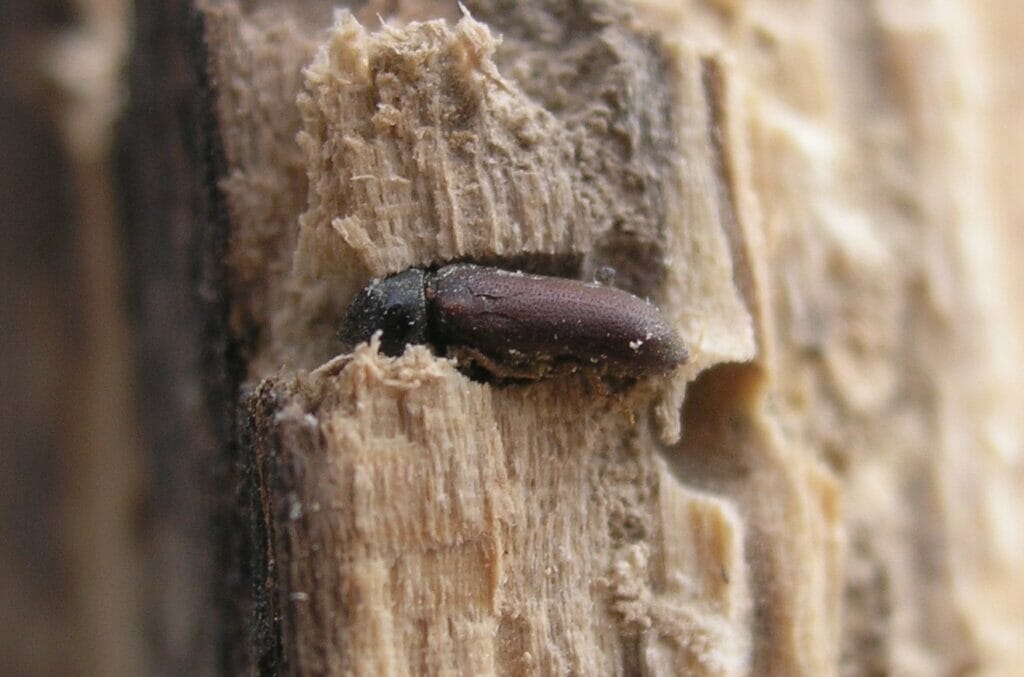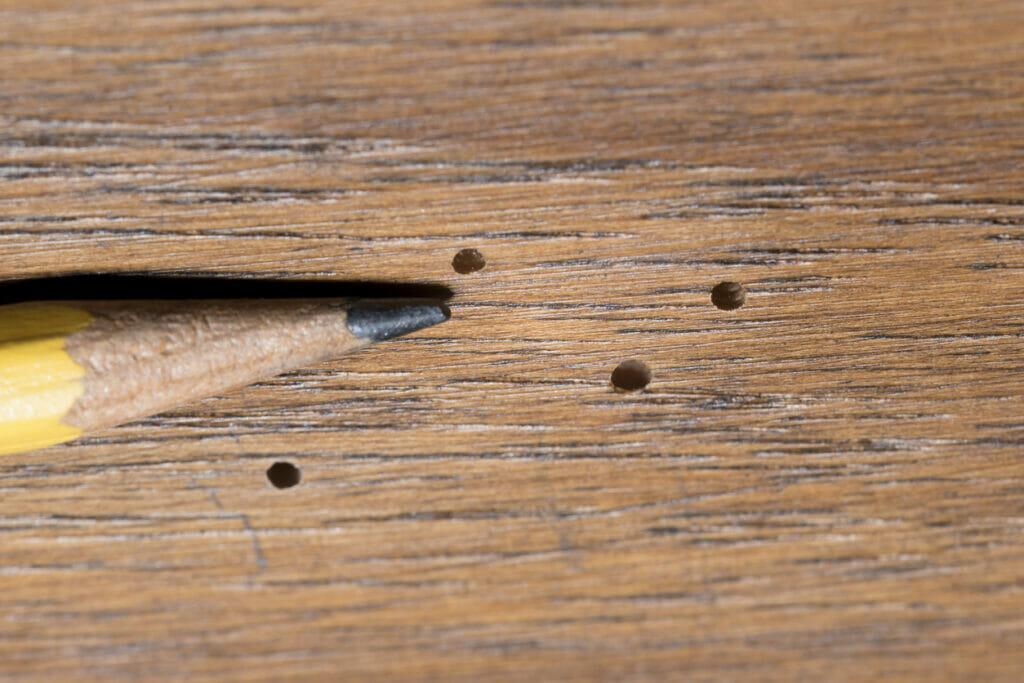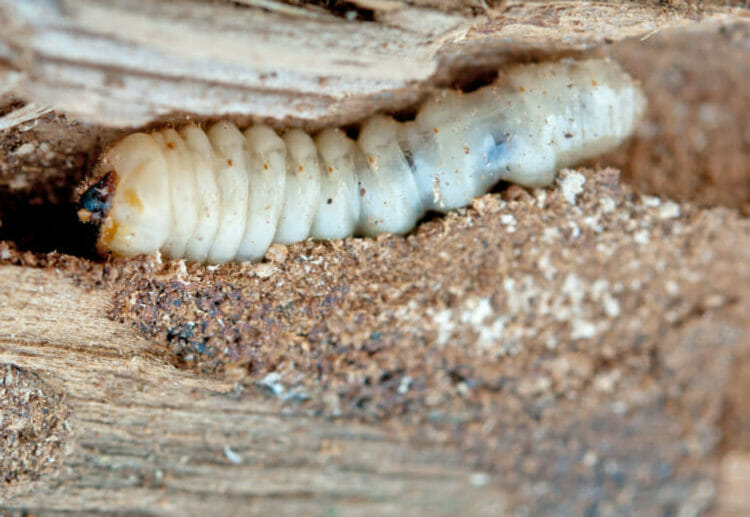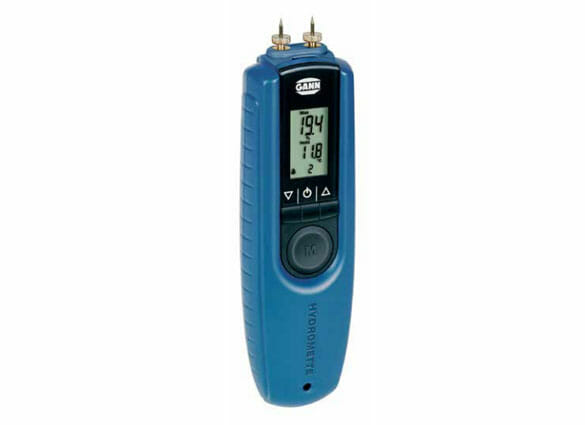Table of Contents
To understand why woodworm is so challenging to identify you have to learn about their life cycle.
Woodworm larvae (the immature insect) bore their way into structures like timber and wood. The larvae then stay in this state within the wood until they reach maturity. At this point, the grubs start to eat their way through to the surface of the wood, pupate and exit as adult beetle.
This process takes anywhere from two to five years to complete, and due to this, our woodworm professionals often visit homes where the problem has already spread to multiple areas.
In this article, we’ll look at the top signs that woodworm may be present in your property and how you can prevent a woodworm infestation from ever occurring.
Woodworm is not easy to spot
As mentioned briefly in the introduction, spotting a woodworm problem is hard.
With that being said, if you do recognise any of the signs our woodworm expert states, get in contact with our specialist team straight away.
We’ve carried out woodworm treatments in London on properties that have remained untreated for many years. But, trust us, the damage these insects cause to the timber structure of your property can be very costly.
And that cost is not from a woodworm treatment perspective.
Expect to repair the timber and structure of your property once the woodworm infestation has been completely eradicated.
Six signs of woodworm
Let’s move on to the six main signs that woodworm may be present in your property.
Holes in wood
The most obvious sign is visible holes in your wood or timber, otherwise known as “exit holes.”
These exit holes are tiny in size, around a few millimetres (2mm) in length. However, the size depends on the woodworm species causing issues.

These tunnels are due to the life cycle of woodworm and are caused by adult wood-boring insects such as the House Longhorn Bettle and the Common Furniture Bettle.
Once you notice holes in your wood, the infestation has already reached maturity.
But don’t lose hope; if you’ve spotted this early enough, a professional woodworm eradication program will prevent any structural weaknesses from developing.
Furthermore, depending on whether they are active (fresh) or not, exit holes could indicate that a woodworm infestation is no longer present.

If this is the case, and you’ve had sign off from a professional that an infestation is no longer present, you can relax and complete a woodworm prevention program. Treat your floorboards, ceilings, joists, beams and furniture with a quality wood preservation product.
Live woodworm sightings
During the summer months, otherwise known as the woodworm season, you’re likely to spot live woodworm.
We must point out; these won’t be actual worms. Instead, they’ll be adult beetles emerging from their exit holes.
Expect to see live sightings of woodworm during May and August.
The first place to look would be the timber and wood itself. Next, look at window ledges for live beetles.
Dead Woodworm sightings
Once a woodworm reaches maturity and leaves the infested timber, they have a very short lifespan.
Females tend to live for around 14 days, whereas males only live up to 4 days.
Now can you see why spotting signs of woodworm can be challenging?
The whole lifecycle takes anywhere from two to five years, and they only spend a short period visible on the surface.
You’ll be able to spot dead beetles in similar locations to live beetles, around exit tunnels and on window ledges.
Presence of sawdust
Another common sign will be the sighting of sawdust caused by insects damaging the wood.
This powdery dust (otherwise known as frass) is caused by the woodworm burrowing in the timber.
If you’ve noticed signs of sawdust on the floor near your wooden structures or furniture, there is a chance that you may have an infestation.
Due to the size of the exit holes caused by woodworm, it can be hard to spot them at a glance. Therefore, it is more likely that you’ll notice sawdust or “bore dust” escaping from the holes.
Insect damage to wood
If the woodworm infestation is significant, there is a likelihood that wooden structures at your property will become weakened or damaged.
The first noticeable area is floorboards and joists.
It would help if you looked for crumbly edges caused by a significant number of exit tunnels.
You’ll also feel damage which is described as similar to dry rot or wet rot.
You’ll need our expert surveyors to diagnose if the problem is woodworm or rot, as different treatment techniques apply to both.
Run your hands along a suspected area that has an infestation. The wood should feel weak and, in parts, could even crumble away in your hands.
Woodworm larvae
The final sign on our list is woodworm larvae.
You won’t see larvae or grub often as they spend most of their years burrowed into the timber.
However, when checking damaged wood, you may see grub if any wood has broken away.
Larvae are a creamy white colour, curved and have short hairs attached to them.

It is unlikely that you will come across larvae, but if you do, it’s a telltale sign that you have an active woodworm infestation.
What Attracts Woodworm?
Understanding what attracts woodworm to your property can be the first step to prevent an infestation from ever occurring.
Moisture in wood
Moisture content is a crucial factor for an infestation to develop.
Damp wood is easier to chew for woodworm species such as the Common Furniture Beetle.
Damp softwoods give woodworm the best chance of reaching maturity and pupating into adult beetles.
Hardwoods that are difficult for the larvae to chew through are often avoided (woodworm species dependent).
If you suspect that your wood is damp and at risk of a woodworm infestation, you can buy a Wood Moisture Meter.

If the moisture of your wood is above 20%, then there is cause for concern.
Woodworm can survive down to 12%, but it isn’t very certain.
To reduce the humidity of your wood, you can use extractor fans, dry clothes outside and ensure your property is adequately ventilated.
Untreated wood
Paint finished wood will not attract Wood-boring beetles.
You can apply a wood preservative paint to an area and relax because beetles will not lay their eggs in the wood.
If your home has already been infested, then you’ll need to contact a woodworm pest exterminator to treat your home.
However, if no infestation is present and you’ve not yet treated your wood, we advise doing so.
Just get clarification that there is no active woodworm infestation first.
Stop an active woodworm infestation
We know that woodworm thrives in timber and wood, but how can we stop an infestation if one is already present?
Over the years, we’ve gathered experience on what works to stop woodworm infestations and, more importantly, what doesn’t.
Treatment is difficult as the correct technique has to be used to guarantee removal. This is why we can’t say what the correct technique is without visiting the site first. So contact us to arrange a free site survey.
We use three specialist woodworm treatments to stop an active infestation.
- Specialist insecticide application: often, if the infestation is small, an insecticide application will be enough to eradicate the problem. A small infestation would include a piece of furniture such as a desk or cabinet. Typically, the insecticide will be painted, varnished or stained over the surface multiple times to ensure all active lifeform has been exterminated.
- ULV insecticide fogging: our recommended approach is to use a combination of the insecticide application alongside an intensive ULV fumigation. This approach is much more thorough than the application alone and needs two to three treatments depending on the severity of the problem.
- Heat treatment: woodworm thrive in damp areas, so a professional heat treatment is a sure way to kill all eggs, larvae and insects inside the wood.
Species of beetles
There are many different types of woodworm, but more often than not, it’ll be the Common Furniture Bettle causing problems. Insects that get classified as woodworm include:
- Common Furniture Beetle (Anobium punctatum)
- House Longhorn Beetle (Hylotrupes bajulus)
- Deathwatch Beetle (Xestobium rufovillosum)
- Wood Boring Weevil (Pentarthrum huttoni and Euophryum confine)
- Powderpost Beetle (Lyctus brunneus)
- Ambrosia Beetle (Platypus spp)
- Fan-Bearing Wood-Borer (Ptilinus pectinicornis)
- Bark Borer (Ernobius mollis)
Types of wood infested in the UK
Each woodworm species has its prefered type of wood.
Therefore, by understanding what wood has signs of an infestation, you’ll be able to tell the species.
For example, the Deathwatch Bettle tends to infest oak, chestnut, and hardwood that has been weakened by wet rot.
On the other hand, the Common Furniture Beetle tends to be found in roof timbers, lofts and old furniture.
When To Call A Professional
If you’ve noticed any signs of woodworm at your property, you should call our team on 0204 566 5522. We operate throughout all the southeast of England and work heavily in areas such as London.
We’re also proud to offer a 30-year guarantee on any woodworm treatment if our advice and guidance are completely taken up.
Don’t take the risk with an infestation; we offer free surveys to help identify if woodworm is causing you problems.




